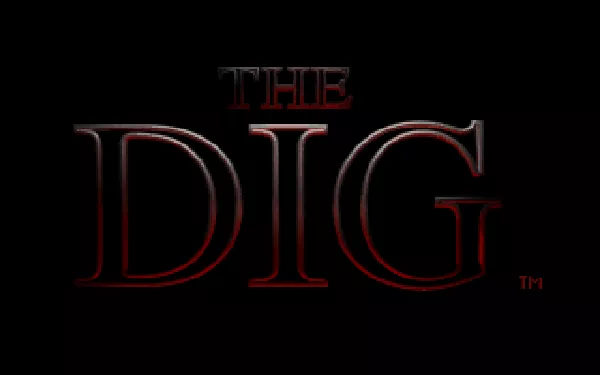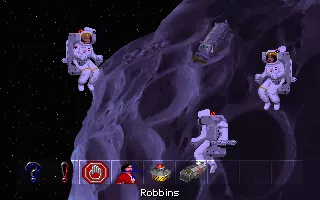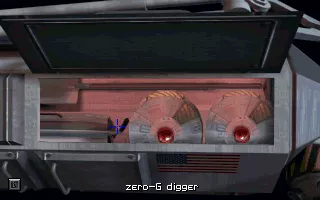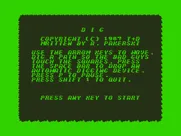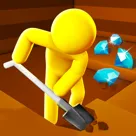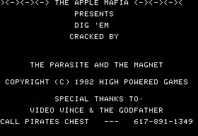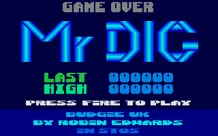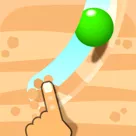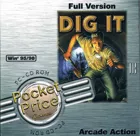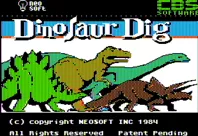The Dig
Description official descriptions
A group of scientists discovers an asteroid that is on its way to a collision with the Earth. Is there any way to prevent the disaster? Boston Low, a NASA veteran, is sent to command a space expedition on the asteroid. Accompanied by the journalist Maggie Robbins and the archaeologist Brink, Boston investigates the asteroid and finds a strange structure that undoubtedly belongs to an alien civilization. During the course of investigations, the team finds itself on a seemingly deserted planet. They have no knowledge of the planet and no possibility of going back. Will they ever discover the secret of this strange world and find a way to get home?
The Dig is a point-and-click adventure game with a simple one-cursor interface. Most of the puzzles are inventory-based, tending to be somewhat more complex than in most preceding LucasArts' adventure games. There are also a few logic-based puzzles, which require understanding and manipulation of alien technology and life forms on the planet. Traditional branching dialogue system is utilized; however, the game focuses more on puzzle-solving than on conversations to advance the plot.
The game's story is influenced by science fiction literature and movies, and strives to be realistic, departing from the comedy style of LucasArts' adventures. Despite that, humorous elements are present in some of the dialogues and text descriptions. The game utilizes hand-drawn graphics with a few pre-rendered 3D images.
Spellings
- 异星搜奇 - Simplified Chinese spelling
- 디그 - Korean spelling
Groups +
Screenshots
Promos
Credits (DOS version)
235 People (207 developers, 28 thanks) · View all
| Designed by | |
| Directed by | |
| Based on a Concept by | |
| Dialogue by | |
| Additional Story by | |
| Additional Additional Story by | |
| Art Style | |
| Creature Concept | |
| Lead Artist | |
| Background Art | |
| Supervising Animators | |
| Animators | |
| Special Effects Animators | |
| Additional Animation | |
| [ full credits ] | |
Reviews
Critics
Average score: 82% (based on 38 ratings)
Players
Average score: 3.9 out of 5 (based on 236 ratings with 21 reviews)
The Good
The art design, while not breathtaking, was actually quite good. The early segments of the game set up some suspense and hinted at a great game ahead.
The Bad
While the early portion of the game set things up well (and "killed" off one of the most annoying characters) the middle and final segments of the game were a complete letdown. With a plot that seemed to have been hacked out of mediocre pulp SF films of the mid-50's, ridiculous dialogue, and characters that seemed to have been stereotyped from the same era as the plot. Oh, and the annoying character comes back as some sort of Undead Bavarian Lingust From Hell.
The puzzles were only average, and some of them were patently absurd and/or obtuse in the extreme. The turtle-thing skeleton puzzle comes to mind.
And I just wonder why so many writers and art directors seem to think that -any- dead civilization would have built with stone in a vaguely Egyptian style, regardless of technical advances. Like they were building their cities with prior knowledge that one day they would vanish and so they should design everything to look sufficiently "ruined". Sure, whatever.
The Bottom Line
If you really like adventure games of the SCUMM variety you might want to check it out. It's not so much a bad game, as a game that isn't a fraction of what it could have been. The story would have been excusable 50 years ago, but today it is just trite and insulting.
Well, ok, it is pretty bad.
DOS · by Patrick Mills (36) · 2000
Whoa, I am gonna meet some Extra-terrestrials man
The Good
Interesting graphics. A good blend of hand drawn graphics, FMV-sequences and animation. I must say they still look good and were kind of superior for it's time.
The Bad
It's repetitiveness. most of the time I was spending time going here and there, going back, going back and going back some more. I would like to see some variation here. Too many times I was wasting time unlocking doors and putting pieces back together.
The story is the biggest let down here. Since there is some budget and possibilities I would expect to be impressed with creative aliens but instead of that I was treated to the same old mystery crap, where aliens don't show up until the very last seconds of the game. The story isn't actually that original. There are worlds that look identical to ours, with beaches, blue skies and mountains. There are rats that look like rats, birds that are birds, dogs that are dogs, bats that are bats and even a ginormous spider. On top of that as some sort of final insult that alien leader says: "those creatures haven't evolved yet". Oh dear...
Also there is one part I simply can't get over with, how on earth is it possible to learn (and speak) a complete alien language just by analysing a few samples in a library?
The Bottom Line
The dig: I rather leave this one buried
DOS · by tante totti (14) · 2007
A Sci-Fi Adventure Game suffering from an Identity Crisis
The Good
The Dig is a science fiction, point and click, graphic adventure game, which was made when LucasArts was still in the adventure gaming business.
The basic plot of the game is as follows: In the mid-1990s a group of scientists discover that a large asteroid is going to smash into Earth, unless something cool and scientific can be done about it. A team of smart and easy-on-the-eyes men and women are assembled to blow up the asteroid.
Naturally, as a science fiction-themed story by LucasArts, the plot quickly shifts to an alien world with lots of puzzles, mysteries and strange creatures that might just eat you.
I cannot really find fault with the game's plot, the game play mechanics are easy to pick up (especially, if you have played other LucasArts adventure games) and both the game's graphics and music are quite excellent for a 1990s, graphic adventure game.
The Bad
My major complaint with this game is the simple fact that the overall tone of the game seems to be going through something of an identity crisis.
The Dig seems like it wants to be a dark sci-fi game, but (I suspect that) somewhere along the game's development someone made the decision to tone down the darkness in favor of a more family-friendly adventure.
The result is graphic adventure game that is not really made for young children (characters die in some rather tragic ways), but the game also lacks the blood, gore and other dark sci-fi elements that would appeal to older gamers.
Some of the puzzles in the game are also way too difficult for young children (or older, average gamers).
The Bottom Line
The Dig is a well designed graphic adventure game that fans of the gaming genre ought to try out. Its science fiction-themed story is certainly entertaining, if a bit unsure as to what it's intended audience is.
DOS · by ETJB (428) · 2021
Discussion
| Subject | By | Date |
|---|---|---|
| Messy credits | chirinea (47496) | Jun 16, 2007 |
| How did you like the voice acting in this game? | LepricahnsGold (142748) | Jun 8, 2007 |
Trivia
1001 Video Games
The Dig appears in the book 1001 Video Games You Must Play Before You Die by General Editor Tony Mott.
Alien and planet name
The planet and aliens are not given a name, however the credits refer to the "Cocytan leader".
In the novelization, Brink decides to name the planet "Cocytus" from Dante's Divine Comedy, Cocytus being the exterior circle of the Underworld and the only way out. The aliens thus are referred to as "Cocytans". However, these concepts are not taken into consideration in the game.
Development
The Dig is based on the original concept of Steven Spielberg who originally created the storyline to be an episode in his Amazing Stories tv series. It would have been too expensive to shoot, so Spielberg approached LucasArts in 1989 with an idea of making it a game. The game itself went through several re-writes at LucasArts, so only the main storyline and a couple of puzzles were carried out from Spielberg's original ideas.
The Dig went through three phases of development while in production, each with different project leaders.
The first phase was led by Noah Falstein. In this version, the game was set upon a jungle planet, very unlike the final version. One major part of this version apparently was that you had to collect and consume food and water to keep your character alive.
The second phase was led by Brian Moriarty. Moriarty tossed out all of the old art from the first version, as well as the "collecting resources" RPG-style elements.
In this version, there were four characters: Boston Low, Ludger Brink, Judith Robbins, and Toshi Olema, a Japanese physicist. As in the final game, this crew was transported to an alien planet via a ship disguised as an asteroid.
This version was controlled via a standard LucasArts-style interface at the bottom of the screen containing visual icons for the functions Examine, Pick up, Use, Move, and Talk, as well as inventory items. Strangely, the game was not programmed in LucasArts' standard SCUMM engine, but instead something called StoryDroid Development System.
After a long series of internal conflicts, Brian Moriarty left the company and Sean Clark took over the project. Clark was the one who actually got the game finished. He changed Judith's name to Maggie and removed Toshi Olema from the plot.
In early betas of Sean Clark's version, the characters looked the same as they did in Brian Moriarty's version (with Low and Robbins both having blond hair). These sprites were later changed and made more visually striking.
In addition, though early betas of this new version used an interface at the bottom of the screen with the same icons for interaction as in Moriarty's game, this was later rejected for the final "one-click-does-it-all" interface which the public saw.
Also, the voices in the final game were not the same as those heard in early betas of Clark's The Dig. Those unused voices lasted long enough to be present in the official demo of The Dig.
Extras
Some copies of The Dig came with a free copy of the Trade Paperback version of Alan Dean Foster's game novelization (a $12.95 value according to the box sticker).
Novel
Although there's no movie based on it, there is a book based on the game, also called The Dig, written by science fiction writer Alan Dean Foster.
References
- Main character Boston Low is voiced by Robert Patrick, who incarnated the evil liquid terminator in the movie Terminator 2. At one point in the game, Boston shows Maggie a photo of lost comrade Brink, and asks her "Have you seen this boy?", paraphrasing the evil terminator's trademark question in that popular movie. Also, when the player looks at his PenUltimate he's gonna say that it's the "T-1000 Model".
- According to the game's demo, the ship that carries out the Attila mission in the first part of the game is Space Shuttle Atlantis. However this reference was cut from the final game.
Shapes
Take a look at the PenUltimate communicator and you will notice that there is a geometric shape on it. It is what the plates inside Atilla look like when they are put together.
Soundtrack
Even though Michael Land's score for the game was released on CD (albeit in a very low amount), it suffered from the worst 'disease' of all official soundtracks, painfully well known to collectors of film scores - it was cut, and not all the music appearing in the game was included. However, the tracks can be extracted with external utilities. Details can be found in the tips & tricks section.
Title
After finishing the game, you might start to wonder if the game's title is in any way connected to the over-usage of the shovel item in the game (main character digs holes every now and then, and rather often), because there is definitely no dig site to explore (not assuming half-blasted asteroid).
Awards
- Computer Gaming World
- November 1996 (15th anniversary issue) – #3 Top Vaporware Title in Computer Game History
Information also contributed by ATMachine, Boston Low, ClydeFrog, Daniel Albu, Dirk Struan, G J, Jaromir Krol, MAT, Swordmaster and Trixter
Analytics
Upgrade to MobyPro to view research rankings!
Related Sites +
-
GJ's Dig Site
Character profiles, images including ads, screenshots, backgrounds, etc, humour. -
Hints for The Dig
These won't spoil the game, but will give you just what you need to solve the game. Final solutions are included. -
ScummVM
Get "The Dig", as well as many other adventure games, to run on modern systems by using ScummVM, a legal and free program. -
The Dig - FAQs & Guides
Several walkthroughs and other files on GameFaqs.com -
The Dig Museum
Includes interviews with creators, creation information, and "Ask Yoda" section. -
The Dig Soundtrack
Music from the game -
The Dig Walkthrough
Start to finish solution for The Dig
Identifiers +
Contribute
Are you familiar with this game? Help document and preserve this entry in video game history! If your contribution is approved, you will earn points and be credited as a contributor.
Contributors to this Entry
Game added by robotriot.
Linux added by click here to win an iPhone9SSSS. Antstream added by lights out party. Windows added by MAT. Macintosh added by Jason Savage.
Additional contributors: Mickey Gabel, Unicorn Lynx, Jeanne, Apogee IV, G J, CubbyKatz, CaesarZX, Picard, Patrick Bregger, FatherJack.
Game added November 1, 1999. Last modified April 12, 2024.





